Testimonies
Here is a selection of testimonies submitted to us via e-mail or Facebook, and originally published on our Hungarian-language website. These testimonies were selected and, unless stated otherwise, translated into English by Gwen Jones. To submit a story, please write to bertalan@ceu.edu.
2014. February 20., Thursday
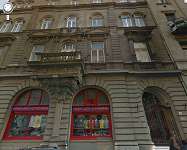
My mother—who is now 92 years old and was called Mrs. Lajos Csapó then—lived from 1943 at Dohány Street 61, third floor, apartment no. 7. First the next-door house, no. 59, became a yellow-star house, and then no. 61. My mother and her husband were the only non-Jews in the house. Their neighbors were [the composer] Rezső Seress and his wife, Helén Spiczer. Seress played piano in the Kulacs restaurant and my mother’s husband, who was a reservist lieutenant, organized permission for Seress to be able to return home outside the curfew hours.
Seress was later taken into forced labor service, and my mother brought him things to eat. Helén stayed in Budapest, and my mother brought her own mother’s (Mrs. Balázs Kovács, widow) papers from Mezőtúr to Helén. Using these, Helén hid in Buda, maybe on Bürök Street.
On the second floor lived the Feldman family, the father had a jewelry stand at the stock exchange. My mother took their daughter, who was 3 or 4, for a walk every day.
On the third floor right next door to my mother lived the Schulcz family, the mother was called Olga, with two sons, aged 10-12. Mr. Schulcz had been taken on forced labor service, and the rest stayed in the apartment.
When they heard that the Jews were being taken from Dohány Street 51, my mother hid Mrs. Schulz and her two sons in the windowless bathroom that opened off from the bedroom, and pulled the large bedroom wardrobe in front of the wallpapered door. The soldiers arrived almost right away and looked for Jews in my mother’s apartment too, they searched everywhere, even looking inside the bedroom wardrobe, but did not find the people in hiding. Apart from them, there were hardly any people living the apartment any more, and an elderly Jewish couple who lived on the ground floor were snatched away.
My mother hid the Schulcz family for a further two days. We don’t know what happened to them, it was said that they might have gone to Caracas.
2014. February 19., Wednesday

My maternal grandparents lived at Erzsébet Boulevard 34: Miksa Katz and my grandmother Frida Fájge Róth, and their sons Sándor (b. 1913), József (1915) and Ede Tibor (1921). By that time, all three of them were dead: the two oldest in Ukraine, the youngest died in October 1944 on the way home from Bor. My grandfather ran a textile business on Kálvária Square with his cousin, Uncle Káldor. The Erzsébet Boulevard 34 house was owned by the well-off […] family, who had a textile business at the entrance: both the house and the business were called the “Spitz house” after the owner. It would be good to know more about the family. In one half of the shop they sold clothing fabric, and in the other, haberdashery (and it’s still exactly the same today). My middle older brother worked as an assistant in the shop. Before forced labor service he had got married and moved out into a rented apartment, but was soon taken away, and perished. His wife died in 1980. My brother Sándor worked at home drawing embroidery patterns onto tracing paper with a stitching machine. Tibor was still studying some trade. My grandfather was in charge of the synagogue in the house. We could see into the rear courtyard from their window, where Succoth tents were erected. As far as I recall, the synagogue could accommodate fifty people. I remember that during Simchat Torah, we children went around with little flags and sang. In the next-door apartment there lived a young couple with lots of children. A new one was born every year, and the smell of pee and children crying emanated from their place. After the war, they never returned to their apartment, and what happened to them never became clear. My grandfather kept an Orthodox household, and I often took the Sabbath sholet to the baker on Dob Street. There was an elevator in the house, which became infamous when a young woman fell down the shaft to a terrible death. My grandparents survived the Holocaust in the ghetto. My grandfather died in December 1945 at the age of 58.

The house was built in 1938 when the first residents moved in. For its time, the building had outstanding features: central heating, central hot water, an elevator, everyone had their own plot in the garden, a telephone to the house supervisor, and a separate laundry room. On the ground floor of the four-story house, on one side was the house supervisor’s service apartment, and on the other, was a one-room, alcove apartment with a room for staff. Opposite and above one another on the right-hand side were three-room apartments with a hall, all the modern conveniences and a room for domestics. On the left hand side, the apartments were the same, except minus one room. Future owners had already decided while the house was being built where the dividing walls should be, in other words the layout and size of each room. After the original plan was drawn, two apartments added modifications. There were five business premises on the street-facing side. (It is interesting that György Gyuricz’s company who built the elevator didn’t do the work for money, but with the ownership rights for the businesses in mind.)
From the beginning, the house functioned as a residential house, so everyone who moved in was an owner as well. Accordingly, there weren’t very many young people among the residents, only definitely well-off middle-class people could afford to move into their own apartment. And so the residents were a mix of Jews and Christians living peacefully next to one another. It turned out later that only the concierge was a member of the Arrow Cross Party. The other buildings became yellow-star houses at the same time. This didn’t lead to conflict, everyone saw it as a kind of protection, they sat and were afraid together in the basement shelter. Naturally, this peaceful state of affairs did not prevent some residents from plundering the apartments of their fellow residents who had been taken away and murdered in late January 1945. After the war, the Arrow Cross concierge disappeared without a trace. The building only suffered minor damage in the fighting, when a section of the roof and fourth floor collapsed.
After the war, only two apartments changed hands: one of the owners sold theirs, and the other left Hungary illegally (defected). This latter property and its businesses ended up in the state’s possession, which in effect meant that the district council handled it. Interestingly, the profile of owners in the house changed very little over the decades, right up until the early 1980s. It turned out in the late 1960s or early 1970s that although one of the business premises had been nationalized, but they forgot to change the deed of ownership, and so the original owner (or rather, the person who inherited the premises) recovered the right to the property.
There was no conflict between the residents in 1956 either, they went down into the basement shelter during the day and only left it at night. This lasted until a group of revolutionaries announced that they were leaving in a hurry now, but would be back for the Jews. Whoever could, fled to relatives or friends, and waited for the fighting to end.
Városmajor Street from Kékgolyó Street to Csaba Street: in 1938, on the odd-numbered side of the street between no. 5 and 13, there were only single-story buildings that were later demolished, and today’s houses erected in their place at various times. Of these, at no. 13, was the painter János Halápi’s apartment and workshop. The single-story house at no. 17 is still standing today, and from there until Csaba Street, all the houses are from the pre-war years, except the swimming pool next to the school on the corner. On the even-numbered side, at the corner of Kékgolyó Street, there was a single-story building, just like at numbers 14 and 22.
The area was particularly quiet, calm, and middle-class. Residents knew each other at least by sight, and greeted one another. Everyone kept the written and unwritten rules of cohabitation, and in the early 1980s, everyone even had their “own” parking space on the street, which nobody else took.
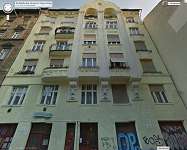
Akácfa Street 43 was also a yellow-star house. I moved in here together with my mother in in June 1944, because this is where my grandparents lived, Rezső and Rózsa Tannenbaum, and their daughter Margit. Later, my mother’s two older sisters, one with her husband, also moved in. There were 8 of us at my aunt and uncle’s, in a small apartment with 2.5 rooms, and we hardly had anything to eat. It was from here I attended the Madách high school wearing my yellow star, as long it was still possible to attend school.
On October 13 my father, István Weisz, received 2 or 3 days’ release from the forced labor camp and came home, and when he left us to return on October 15, the day of the Arrow Cross putsch, he was caught by the Arrow Cross and, half beaten to death, staggered home into the house. Two days later he was caught by them again, and taken to Buchenwald, from where he never returned. Today, the house’s façade has been restored, but inside it is exactly the same as it was before. The house later fell within the territory of the ghetto.
When we received the news that they intended to set the closed Pest ghetto on fire, a group of resistance activists dressed as the Arrow Cross came in November to rescue us from Akácfa Street 43. They escorted 8 of us to the protected house at Szent István Park 25. I was 13 years old at the time. My older sister was already waiting for us there, and so nine of us occupied a corner of one room in a first-floor apartment. There were at least 4 other families living in the apartment, the windows had been smashed and it was often -15C outside. We burned almost all the furniture to keep warm, and hardly had enough to eat. The plumbing only worked in the basement. The Arrow Cross gathered us together in front of the house on two occasions, with the clear intention to shoot us at the Danube, which was barely 80 steps away. Both times, we referred to the Arrow Cross leader living in the next-door house, and both times they let us go. On January 15, the Russians occupied the house, but for a long time we had nowhere to go, and stayed there starving until at least February or March 1945.
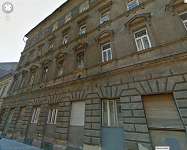
My family and me were in the “Csillagos ház,” Wessélenyi Street 61 in 1944. We were cramped in a small apartment on the second floor with two other families. We were five of us, I was only 10 years old and it was very difficult and full of suffering for all of us. My father was only able to work on selected days and we just hardly made it. On October 19th, the Arrow Cross thugs took my father, and that was the day when I saw my beloved father the last time. He was killed by the Arrow Cross. On November 1st with the help of my late uncle who worked in the Swedish Embassy, we were able to escape and my younger brother and I were placed in a “safe house” in Lónyay Street 9, which had Swedish protection. My mother and older sister were placed in a Catholic Convent which was also “protected” by the Swedish Embassy. Raoul Wallenberg was the hero and I vividly recall that one day in November, Raoul Wallenberg personally came to save us from the Arrow Cross thugs. Mid-December 1944 we had to escape from the “safe house” because the most horrible Arrow Cross thugs wanted to take us. My mother felt that we should walk to the Ghetto. While we walked in the city the Arrow Cross members stopped us and transported us to one of their “Terror Houses” which was on Andrassy Road 47 (near the Octogon). The Arrow Cross Thugs were the most primitive murderers and as a 10-year-old I saw just killing, blood and the worst human suffering. After almost 70 years I’m still suffering from that unbelievable experience!
From Andrassy Road 61 in early January, 1945, the Arrow Cross were taking us to the Danube for execution but the leading Arrow Cross member was drunk and the older people in the group convinced the Arrow Cross guy (Nyilas) to walk us into the Ghetto. January 18, 1945 the Russians liberated the Ghetto and we were the few lucky survivors. During the Holocaust (vészkorszak) I lost 17 of my immediate family, my father, older brothers, aunts, uncles and several cousins. I told this sad story to several young and older people, both Jews and Gentiles. The entire world must forever remember for the Holocaust in the memory of the 6 million Jews murdered by the Nazis. (Although “New Nazis,” the “New Arrow Cross” in Hungary, Iran and other Thugs are claiming that the “Holocaust is a myth”... This is the main reason that Israel must be very important for every Jewish person and for Gentiles as well.
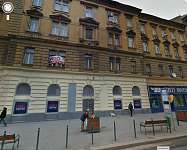
I remember: my father was somewhere in Russia “defending the homeland,” and my mother stayed at home with 2 children, in those dreadful times. One day she started coughing blood, it was diagnosed as tuberculosis. We were moved to somewhere in Zugló near the church with my mother in this state, this was the first yellow-star house.
My grandmother hurried to help us. My mother ended up in the János hospital in Buda, and we children “moved” with our grandmother into the second yellow-star house at Népszínház Street 30. I write “moved” because we didn’t move but were taken: the elderly grandparents, me, and my 4-year-old sister.
I’d already got over the humiliation when, one day, when we were still allowed to go to school, the yellow-star was not on my coat, it wasn’t visible. For this, my mother was taken to the police station and beaten. Maybe this is why she later coughed blood?
The “apartment” at Népszínház Street: 14 adults and 2 children crammed into a two-room apartment. There was a curfew, which meant our grandmother always had to hurry to reach my mother in the János hospital and come back in time. There was hardly anything to eat at the hospital, so my grandmother had to decide whether my sick mother or the children should eat. The windows looked onto what is today John Paul II Square, so we had some fresh air.
But there were good things too. I always wanted to be a teacher and we played school in the stairwell of the yellow-star house. We fell in love too, as 9-year-olds do. If there was an air-raid, we couldn’t go down into the basement, and so waited for the Stuka planes and the bombs upstairs.
And then came the next terror: October 15, 1944. We listened to the news of events, but soon had to WAKE UP to the facts, as the next day, we were taken to the Tattersaal racing track.
My uncle, who was 75 years old at the time, was kicked down the stairs. We stood there all night on the track, STANDING, my grandmother with my 4-year-old sister in her arms, and they threatened her with a pistol because my sister took a liking to some shiny object. We spent two nights like this, and by the time we came home, the apartment had been plundered.
Hanging on a nail in the pantry was a bag with flour and groats, but from outside they felt the same, and my grandmother picked the bag of groats, which she cooked in water and we ate for days. We had to read every day, without light, and grandmother taught us poems she knew off by heart. Is why I became a Hungarian teacher later? Of course, every day there were raids, and whenever they found someone in the apartment, they took them away. These were Hungarian Arrow Cross men!
And this is how we “lived” until the end of November, when ghettoization began. They led us down Népszínház and Rákóczi Street, right to Klauzál Square. That’s where they took away my doll and small basket. This was what hurt me the most. We “lived” in the Pest ghetto from the end of November 1944, in the middle of raids, starvation and illness. A bomb landed in the basement and my 4-year-old sister was evacuated from there. Forced laborers who had left their units came to find refuge. It’s there that I stole something for the first and last time in my life, some tin of preserved goods, and my grandmother gave me a great telling off.
Two months in the ghetto, during the siege of Budapest. We were liberated on January 18, 1945. Russians liberated me and my surviving relatives. They tore the yellow stars off our clothing and gave us food. And what happened after is also history, but it’s my history.
My mother died at the age of 31, and my foster-mother returned from Auschwitz. 52 members of my family disappeared, including my grandfather, who disappeared from the yellow-star house. My daughter never spent holidays in the countryside – we had no relatives living there any more. I stayed here to teach Hungarian literature, and my younger sister left 45 years ago for a far-away country. Was she the smarter one?!
Why didn’t we rebel? Dear contemporaries of today! Old people and children rebelling against armed men?
At least today I can make my voice heard and I think that’s something. That’s all for the moment. Ask away!

My family lived and was liberated in Teréz Boulevard 7. I was three years old. The Russians were already at Nyugati railway station when the Germans entered the house. They asked whether there were any Jews here, and received the answer that there were only German workers in the house. The Germans were tired, they ate and slept. Three people left the house via a drilled-out tunnel into the next house, and from there to Nyugati, and brought the Russians back to the house. For both me and the house, this was liberation.
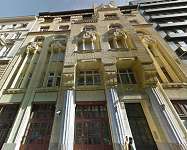
When it came time to move into the yellow-star house, a second floor apartment at Akadémia Street 7 was designated for us. My mother, her parents, my younger sister and I moved in there together into a narrow room, but at least we could be together. The apartment had originally belonged to my grandmother’s older brother, Dr. Károly Fillenz. There was a vast mount of people squeezed in there together, around 38-40 of us, most of whom were related. We only knew the other residents of the house by sight, and I remember the family name of Adler.
Horthy’s proclamation caused much excitement, but the next day the Arrow Cross broke into the house, and ordered every man aged between 16 and 60 down into the courtyard. They took away Grandfather and Uncle Károly and all the other men in the house. They never returned. Adler was the only one in the house who escaped and returned home. It’s from him that we know they were taken to Dachau, and the old ones were killed the very same hour they arrived.
Some days later more Arrow Cross men came, young men in their teens, and herded all the women together. They took our mother too. After a terrible, nerve-wracking three days, she came home. They had been taken to the Óbuda brick factory. There were thousands of them there, desperate girls and women. Our mother was rescued by a distant relative who was working as a Zionist, who didn’t wear the yellow star, and who went about in public wherever he could. He went to the brick factory to get his wife, and because he knew our mother well, he managed to bring her and a few other women out too. The yellow-star house was almost completely empty. We didn’t dare to stay there either.
A relative pointed us to Pozsonyi Road 41, which was under Swiss protection. As the photo shows, the house on Akadémia Street, with its beautiful, grand, middle-class apartments, was one of the most elegant on the street. Because of my memories connected to the place, it isn’t this beauty that I remember, but what we experienced there of the horrors, tragedies, numerous suicides, and finally our loved ones being dragged off.
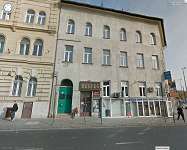
At Széll Kálmán Square 10 lived the two owners of the house, Dr. Kálmán Balkányi with his wife Edit Vészi and their children, and his brother, Béla Balkányi. Andor Márkus also moved in with his wife Lenke Vészi and their children. Béla “never came back.” Luckily, the others survived, most of them by going into hiding, and in the period after 1945, all of them emigrated, at different times: Paris, London, Buffalo. I asked my relatives on my mother’s side, Anna Mark, a painter in Paris, about the family story. Based on the writings of Dr. Gábor Márkus (a cancer researcher in Buffalo), and supplemented by his sister Anna, there were other relatives and families we knew living in the house, but we do not anything more about their later fate.
“The worst was when Jews had to move into apartment buildings, which were marked with a big yellow star: Jewish-houses. Since the house we lived in was not a Jewish house, we had to move. The house belonging to my uncle Kálmán Balkányi in Buda became a Jewish house, and we moved there. We lived in rather cramped surroundings, but at least the family was still together.”
“At that time, in the summer of 1944, a concentration camp was constructed at the Deaf-Mute Institute. [...] Lots of people felt that it would have been better to return to the Jewish houses than to stay there in the camp guarded by the Gestapo. Strangely, this was possible, and our family went back to my Uncle Kálmán’s house in Buda. Then there was a relatively calm period, in which young Jews like myself worked on public works projects around Budapest.”
Anna writes: “We had only been in the Jewish house for a short while when the Arrow Cross came and took all the men away. They could take a backpack with them (and everyone always had one ready packed) … A few days later the posters appeared, which said that all women over the age of 16 (I don’t know what the upper age limit was) had to go on such-and-such a day with a backpack to the Vérmező [...] so we filed in, and they took us to Csomád and Imreháza to dig anti-tank traps. About three weeks later they said we were de-mobbed and dispatched us [...]. The Arrow Cross handed us over to the gendarmerie, who took us to the outdoor swimming pool at Pünkösdfürdő, where there were little cabins with overhanging roofs. This was a holding camp where there were also men. We started looking for someone from the Széll Kálmán Square house, and we found them, and this is how we found Papa and you.”
Márkus saved Andor, and Géza Petényi saved Gábor from the forced march, and Anna and Zsuzsi Balkányi also escaped from the line.
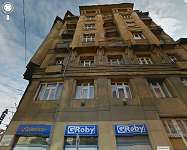
I was born here in 1934 (Erdélyi Street 19, second floor, apartment no. 3). This is where I spent the first ten years of my life with my whole family. In June 1944, the building became a yellow-star house. After the Arrow Cross takeover of power on October 16, the Arrow Cross broke into the house. They killed a half-witted boy on the spot, drove the residents out on the street with their hands up in the air, and made them march like this to a house (on what was I think Nefelejcs Road, but am not sure), where they were placed in another unknown apartment. Before this everyone was made to wait in the courtyard and if anyone had any jewelry, it was taken away. But we waited the whole night because the apartment was full of bedbugs. About 2 or 3 days later, the group was escorted by the Arrow Cross back to Erdélyi Street 19. As we learned later, the Arrow Cross leader’s lover lived in this house and came here to get some rest. This was lucky for us.
Then in November everyone had to move into the ghetto or a protected house. My mother, her brother, me and my younger sister found a place in a room at Sziget Street 40, where lots of other families lived, and the four of us slept in one bed. Seeing the impossibly cramped conditions, they managed to get me and my sister into a Calvinist institution, where we managed to survive the war. Meanwhile, my mother and her brother were deported to Bergen-Belsen in early December. Painful memories.
I hope that someone will read these lines and get in touch, because since then, I haven't heard anything about anyone.